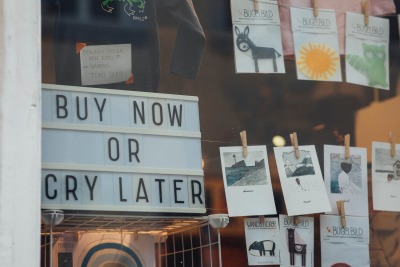5 Ideas to Promote Your Product When Consumer Spending is Down
When your business experiences a drop in sales, it might make you feel a bit helpless. Many managers might batten the hatches and hope to ride out the storm.
But there are demonstrable ways to combat the reduction in consumer spending and encourage growth even during difficult trading periods. Here are a few of Epos Now’s tips for marketing your products to more hesitant customers.
1. Build a presence in new places
Consumers buy your products to meet their needs or desires. The first business they find that they feel is capable of filling that need will win their custom. As a result, companies benefit from researching and considering where to push their brand to put themselves first in line.
Many consumers’ first look at a product or service happens online these days. The prevalence of webrooming (researching a product online and buying in-store) and showrooming (researching in-store before buying online) reflect the close relationship between the eCommerce and high-street worlds.
The statistics on these trends are pretty clear. 88% of internet users (and who doesn’t use the internet these days?) say they have done online research before buying products in-store[1]. The same poll found that 76% of consumers bought online after learning about products in stores.
These trends mean the ideal marketing strategies will explore both avenues to reach potential customers in different ways. Businesses that haven’t yet, or aren’t suited to, eCommerce can still benefit from a website or blog and local inventory advertising. They can also market on social media for next to no cost at all.
Advertising your products online has never been so easy with Epos Now’s NearSt integration:
- Let people nearby know you have what they’re looking for with easy-to-use local inventory advertising
- Advertise on Google, Facebook and Instagram whenever customers search for terms related to your products, so none of your advertising budget goes to waste
- Synchronise NearSt with Epos Now so that you control which products get maximum exposure and who you want to target with your marketing

2. Reach people more directly with physical advertising
A lot of advertising is online these days, but reaching new customers doesn’t have to involve the internet. In particular, online businesses might consider the marketing and branding power of a physical presence. You may reach fewer people, but you can more profoundly impact those who engage with your business.
This may be through physical advertising like billboards, but it could also include pop-up stalls, special events, and many other alternative forms of marketing. Customers that only engage with a business online can feel more distant. Something tangible, like mail-delivered leaflets, can help you have a physical presence in your customers’ lives.
3.Rebranding your product as essential
Even with your products well placed and widely recognised across platforms, you may still struggle to sell during tough economic times.
Harvard Business Review theorises that customers think about purchases in four main ways: as essential “must-buys”, as occasional “treats”, as postponable “buy-laters”, and as expendable “non-necessities”[2]. Their four different kinds of consumers will reduce expenditure within those brackets differently:
- Slam-on-brake savers will cut out all expendable and postponable purchases while reducing the number of treats they indulge in to maximise their financial security.
- Pained-but-patient purchasers will cut out most expendables, delay some of their extra expenses and drop some of their regular treats.
- Comfortably-well-off consumers will drop some luxuries but will not forego many of their preferred products.
- Live-for-today livewires, the retailer's dream, will not want to reduce expendables and will spend whatever income they have. However, they may not expand into new areas of consumption.
 Harvard Business Review outlines different ways of marketing to these different consumers. Still, in each case, companies selling less essential products will have more work to do to retain revenue during a recession.
Harvard Business Review outlines different ways of marketing to these different consumers. Still, in each case, companies selling less essential products will have more work to do to retain revenue during a recession.
Combatting this means repositioning the business within the market, which doesn’t necessarily mean changing the product itself. What it really means is rebranding or adjusting the marketing strategy to highlight the product's relationship to an essential need in the consumer’s life.
Even luxury items will have time-saving, stress-reducing, or convenient qualities. Focusing marketing materials on such aspects of the product can cause customers to reconsider whether your product is one they ought to cut out of their purchasing habits.
4. Create urgency with limited-time promotions
When consumers look to make savings, expense plays a larger part in every sale. But if your product does not fall into an essential purchase bracket, even low-cost items won’t sell strongly as your customers prioritise other items.
One tactic that can reframe your product in the customer’s mind is a limited-time promotion campaign. These promotions redirect the attention from the actual price of the purchase to the savings they can make if they buy the product right away. Promotions like these break down the barrier between buying products and saving money because savings are made whether someone buys or not.
Psychology Today published a study of limited-time offers assessing the factors influencing their success and how they work[3]. Choosing when an offer should end has a crucial impact, and a business’s market position can change how short it should be.
The takeaways from the study suggest:
- Well-known brands suit shorter offers that increase “anticipatory regret” at missing out.
- Smaller businesses that try to emulate this can inspire a “burden of inconvenience” that can lead to customers rejecting the offer.
- Psychologists believe including a reason for the offer can counteract the burden of inconvenience, creating a sense of inclusion and can increase the offer's attractiveness.
- Anticipatory regret seems to be a more potent commercial force than curiosity or interest in a product, suggesting that “don’t miss out” messaging can push consumers into making purchases.
5. Focus on more economical forms of advertising
When your customer base feels more hesitant about making purchases, maintaining regular contact with them through your marketing channels becomes critical.
Those customers that have read an email newsletter or seen a post about your staff hard at work will feel more connected to the business. As a result, they will be more reluctant to cut out purchases from your store.
Businesses that strategise their CRM (customer relationship management) alongside their usual marketing can boost customer retention by a whopping 27%, with a 29% sales increase[4].
These kinds of statistics reinforce the notion that customers respond to communicative, attentive businesses that maintain a dialogue and build their brand in a direct and personal manner.
Helpfully, the kinds of comms that you can use in CRM tend to be the most economical. Email marketing in the form of a newsletter only costs the time it takes to write it. Apps like Mailchimp integrated to your POS customer base can even help reduce any time spent contacting customers.
A newsletter can retain engagement with customers even when they’ve not been in for a while. They inform your customers about the latest offers and promotions, friendly new faces at the business, and any other exciting news.
Posting on social media can also communicate a lot of similar information that expresses the human, relatable side of your business. When connected to the daily life of your store, customers considering whether or not they want your products don’t just think about a faceless business; they think about you, your team, and everything they’ve read about you.
Want to find out more about ways Epos Now can help you promote your products? Submit your information below to speak to a member of our team




